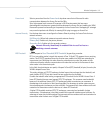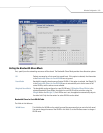
Wireless Configuration 5-21
Antenna Settings
Advanced Properties
Internal/External
Antenna
Specify whether the Access Port has internal antenna or external antenna. Depending on the
antenna type selected certain options in the Radio Settings section may be disabled.
Antenna Diversity
Use the drop-down menu to configure the Antenna Diversity settings for Access Ports that use
external antennas.
Full Diversity: Utilizes both antennas to provide antenna diversity.
Primary Only: Enables only the primary antenna.
Secondary Only: Enables only the secondary antenna.
Antenna Diversity should only be enabled if the Access Port has
two matching external antennas.
Support Short
Preamble
Check the Support Short Preamble checkbox to allow the Access Port to communicate with the
MUs using a short 56-bit preamble.
A preamble is the beginning part of a frame. The preamble comprises such elements as robust
carrier sensing, collision detection, equalizer training, timing recovery, and gain adjustment. The
administration can choose between a long or short preamble for data-frame transmission from the
WLAN’s adopted Access Ports.
Use the long preamble setting (the default) for legacy wireless equipment that is not capable of
dealing with short preambles. Use the short preamble setting where legacy equipment is not an
issue and maximum throughput is desired, for example when streaming video or Voice-over-IP
applications are used.
RTS Threshold
Set the Request to Send Threshold (RTS Threshold) by specifying a number.
RTS is a transmitting station’s signal that requests a Clear To Send (CTS) response from a receiving
station. This RTS/CTS procedure clears the air when many mobile units (MUs) are contending for
transmission time. Modifying this value allows the administrator to control the number of data
collisions and thereby enhance communication with nodes that are hard to find because of other
active nodes in the transmission path.
In this field, the administrator can specify a Request To Send (RTS) threshold (in bytes) for use by
the WLAN’s adopted Access Ports.
This setting initiates an RTS/CTS exchange for data frames that are larger than the threshold, and
sends (without RTS/CTS) any data frames that are smaller than the threshold.
Consider the tradeoffs when setting an appropriate RTS threshold for the WLAN’s Access Ports. A
lower RTS threshold causes more frequent RTS/CTS exchanges. This consumes more bandwidth
because of the additional latency (RTS/CTS exchanges) before transmissions can commence. A
disadvantage is the reduction in data-frame throughput. An advantage is quicker system recovery
from electromagnetic interference and data collisions. Environments with more wireless traffic and
contention for transmission make the best use of a lower RTS threshold.


















